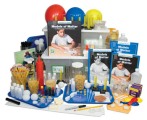Posts tagged ‘physical science’
Forms of Energy: Everyday Examples to Help Students
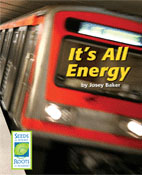 Help students understand energy and its various forms with everyday examples. Students can learn about electrical, motion, sound, thermal, light, and chemical energy with the situations and processes they experience in everyday life. You can finish the lesson with a printable student sheet that reinforces what the students have learned.
Help students understand energy and its various forms with everyday examples. Students can learn about electrical, motion, sound, thermal, light, and chemical energy with the situations and processes they experience in everyday life. You can finish the lesson with a printable student sheet that reinforces what the students have learned.
In the Seeds of Science/Roots of Reading® book It’s All Energy, students read about the many different forms of energy we use every day—to move, talk, cook, create music, light or heat. Below are some examples form the book that you can use with your class to help them understand various forms of energy. Start with a brief description of energy.
What Is Energy?
Energy makes things happen. Every time something moves, it is because of energy. Every time something gets warmer, it is because of energy. Every time something makes a noise, it is because of energy. People use energy to talk, run, and think. In fact, every time we do anything, we use energy!
There are different forms of energy:
- electrical
- motion
- sound
- thermal
- light
- chemical
Electrical Energy
A bolt of lightening is electrical energy. This is the same kind energy used by (more…)
Mystery Forces: A Fun Way for Students to Distinguish Between Forces
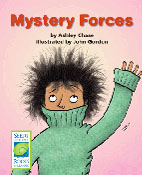 Help students understand that gravity and other forces are at work all around us. Forces can make objects float in the air, stick together, and do other strange things. In the Seeds of Science/Roots of Reading® book Mystery Forces, students read about strange things that happen because of forces. They try to figure out which force is at work in each story. Is the mystery force gravity, magnetic force or electrostatic force?
Help students understand that gravity and other forces are at work all around us. Forces can make objects float in the air, stick together, and do other strange things. In the Seeds of Science/Roots of Reading® book Mystery Forces, students read about strange things that happen because of forces. They try to figure out which force is at work in each story. Is the mystery force gravity, magnetic force or electrostatic force?
Below are some examples you can use with your class, along with a chart that will help them distinguish between the forces. They can refer to this chart when deciding which force is the culprit.
Case of the Moving Spoon
A magician is sitting at a table. She stares at a metal spoon and it slides across the table. You ask her to move a glass. She says her magic only works on metal objects.
How can the magician move the spoon without touching it? Why does her magic only work on metal objects?
What force is at work here? What evidence of the force can you find? What is pushing or pulling on what?
Explanation: In the case of the moving spoon, the mystery force is magnetic force. The magician has a strong magnet under the table. Even through the table, the magnet attracts the metal spoon. When the magician moves the magnet, the spoon moves with it. She can only move metal objects because magnets pull strongly on some kinds of metal. Magnets don’t attract glass or other materials.
Case of the Shrinking Apple Tree
The apple tree in the park used to be taller than the swing set. This summer, lots of apples are growing on the tree. The branches are hanging down. Now the tree is shorter than the swing set!
Trees usually grow bigger. Why is this tree shrinking?
What force is at work here? What evidence of that force can you find? What is pushing or pulling on what?
Explanation: In the case of the shrinking apple tree, the mystery force is gravity. Earth is pulling the heavy apples down with the force of gravity. The branches aren’t strong enough to hold so many apples up. That’s why they are hanging down. With the branches hanging down, the tree is shorter than it usually is.
Case of the Sticky Socks
You pull two clean socks out of the dryer. The socks are stuck together. Why did the socks stick together?
What force is at work here? What evidence of that force can you find? What is pushing or pulling on what?

Explanation: In the case of the sticky socks, the mystery force is electrostatic force. When the socks rolled around in the dryer, they rubbed against other clothes. One sock became charged. The socks are attracting each other.
Forces Chart
Extending the lesson
Explain to students that, in addition to the situations above, mystery forces are all around them all the time. Tell them to be a force detective at home. They can look around for evidence of magnetic force, gravity, and electrostatic force. Their challenge is to figure out which force is at work when they see someone’s hair sticking up or leaves falling from a tree. They can share their stories with classmates and compare experiences of finding mystery forces everywhere!
For more information about the student book Mystery Forces and the Gravity and Magnetism science and literacy unit, visit http://www.scienceandliteracy.org.
Do you want to be notified when we publish new blog articles? Simply enter your email address in the “Follow Blog via Email” box located in the right sidebar.
6 Tips for Students. Communicating the Results of an Investigation.
One of the most important things scientists do is communicate. They share explanations of what that have learned with the scientific community – scientists all over the world. When scientists have explanations to share, they often write reports for scientific journals. Scientists also communicate with one another in person at conferences. They share their data and explanations by giving speeches in front of big groups and/or by presenting posters. This communication helps scientists learn from other scientists’ investigations. When one scientist answers a question, this helps other scientists investigate their own questions.
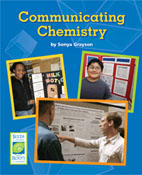 In the Seeds of Science/Roots of Reading® student book Communicating Chemistry, students can read about a chemist who makes a poster and presents it at a conference. Reading about his experience will provide tips for students who want to share the results of their own scientific investigations.
In the Seeds of Science/Roots of Reading® student book Communicating Chemistry, students can read about a chemist who makes a poster and presents it at a conference. Reading about his experience will provide tips for students who want to share the results of their own scientific investigations.
Here are 6 helpful tips for students presenting a poster:
- Think about your audience. Make sure that someone who doesn’t already know all about your investigation will be able to understand what you did and what you found out.
- Keep it simple. A poster should be about what you were investigating, how you did it, and what you learned.
- Before you present, try to think of questions that people might ask you. Have answers to these questions in mind.
- When talking about your investigation, try to make just a few main points. You don’t need to talk about everything that happened.
- Be sure to speak slowly and clearly.
- Practicing your presentation out loud will help you figure out what to say. If you have practiced, presenting will be easier on the big day.
By presenting their ideas, students act as scientists who bring the community one step closer to answering the big questions. The big discoveries in science almost always grow out of work that many scientists have been doing over many years. That’s because big questions can be hard to investigate. Scientists break big questions down into smaller questions that are easier to investigate.
Students can read about Michael Grass, a chemist who presents a poster at a scientific conference, featured in the Seeds of Science/Roots of Reading® student book Communicating Chemistry. Grass has been investigating a better way to make nanoparticles of different shapes, making them better at speeding up a chemical reaction.
For more information about the student book Communicating Chemistry and the Chemical Changes science and literacy unit, visit http://www.scienceandliteracy.org.
Do you want to be notified when we publish new blog articles? Simply enter your email address in the “Follow Blog via Email” box located in the right sidebar.
How Can Students Study Things That Can’t be Seen? Using Evidence to Make Inferences.
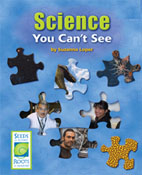 It is common to have students make inferences based on their observations when working in the lab or hands-on science classroom setting. What happens when ice is exposed to heat? What do you see when certain ingredients are added to mixtures? Can you see ink separate during chromatography?
It is common to have students make inferences based on their observations when working in the lab or hands-on science classroom setting. What happens when ice is exposed to heat? What do you see when certain ingredients are added to mixtures? Can you see ink separate during chromatography?
What if a phenomenon cannot be observed directly?
In the Seeds of Science/Roots of Reading® student book Science You Can’t See, students are introduced to the work of three scientists, each of whom studies a phenomenon that cannot be observed directly. Karen Chin studies dinosaurs, Edward Saade investigates the ocean floor, and Farid El Gabaly uses an electron microscope to make images of magnetic atoms. In order to answer their questions, these scientists must make inferences based on evidence. The book also highlights the ways that using models can help scientists make accurate inferences.
Starting with Karen Chin’s study of dinosaurs, the book explains how scientists can use fossils to try to answer questions about dinosaurs. Karen asked: How and what did dinosaurs eat? Though the dinosaurs are gone and they cannot be observed eating, Karen can studied coprolites, which are fossil droppings. Inside the droppings were bits of the plants and animals that dinosaurs ate. From this evidence, (more…)
Help Students Model the Steps of the Design Process by Making Hair Gel
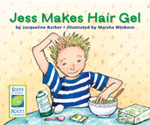 In the Seeds of Science/Roots of Reading student book, Jess Makes Hair Gel, students read an account of a boy who sets out to make his own hair gel. Through the book, students have an opportunity to see the design process in action, complete with obstacles, missteps, and successes that Jess encounters.
In the Seeds of Science/Roots of Reading student book, Jess Makes Hair Gel, students read an account of a boy who sets out to make his own hair gel. Through the book, students have an opportunity to see the design process in action, complete with obstacles, missteps, and successes that Jess encounters.
Students learn:
- there are important steps that scientists follow when they design something
- while each step is important, you don’t always need to follow the same exact steps, in the same exact order
- scientists often need to revise their plans as they go along, based on what they learn
In the book, Jess identifies the properties of a good hair gel and then tests different ingredients to see which have these properties. While conducting tests on each ingredient, Jess realizes that he needs to expand the list of properties of good hair gel to include several more. With this realization he is able to solve problems he encounters and end up with a great hair gel.
You can let your students design their own gels. Ask which ingredients they’d like to investigate. Take this opportunity to teach students to use the word substances. Explain that substance is a word scientists use for ingredient. Possible ingredient choices could include: shampoo, shaving cream, egg whites, corn syrup, gelatin and a glue stick (remind students to check with parents to determine the safety of an ingredient).
Share the important steps for designing mixtures.
- Decide on the properties you want your new mixture to have. (more…)
Celebrate Earth’s Rotation Day with Students
Earth’s Rotation Day is January 8th! Recognition of this day is a great way to incorporate a lesson on gravity.
 First, explain to students the importance of this day. On January 8, 1851, physicist Leon Foucault (foo-koh) demonstrated that the Earth rotates on its axis. The device he used to prove this is known as the Foucault’s Pendulum.
First, explain to students the importance of this day. On January 8, 1851, physicist Leon Foucault (foo-koh) demonstrated that the Earth rotates on its axis. The device he used to prove this is known as the Foucault’s Pendulum.
Without any formal scientific training, Foucault had an insight that no scientist before him had figured out. Check out this video that explains how the discovery became a rotation meter.
The pendulum swings freely to and fro under the action of gravity. Once set in motion, it continues to swing back and forth in a vertical plane defined by the track of the ball and cable. Although gravity is pulling down on the ball and tension in the cable is holding it up, there is no force acting to change the direction of swing. Air friction and gravity would eventually stop the pendulum from swinging, but a magnet encircling the cable pulls on the cable with each swing. Electric current controlling the magnetism is turned on and off with each swing of the pendulum.
 Here’s a nice segue to covering the topic of gravity with students. How does gravity affect their everyday life? In the Seeds of Science/Roots of Reading student book Gravity Is Everywhere, students are told they can’t escape gravity. Gravity is a pulling force. Earth pulls on them and everything around them with the force of gravity.
Here’s a nice segue to covering the topic of gravity with students. How does gravity affect their everyday life? In the Seeds of Science/Roots of Reading student book Gravity Is Everywhere, students are told they can’t escape gravity. Gravity is a pulling force. Earth pulls on them and everything around them with the force of gravity.
In the book, students learn that you can measure gravity. Simply measure your weight on a scale to measure the pull of gravity between you and Earth. The stronger the pull, the higher the number will be on a scale. Here’s a fun way to reinforce this concept with students. Show students the objects on the left side of this table and ask them to put in order the objects being pulled most strongly to Earth – from least to greatest. Then reveal the right side which details the weight. Ask them to report on whether their assumptions were correct.
In addition to the concept of measuring gravity, students also learn about gravity in space. Students will find it interesting to learn that if they visited another planet, their weight would be different there. One fun fact to astound them with is what a kid might weigh on the Sun…1,680 pounds! They would weigh about the same on Venus where the gravitational pull is similar to Earth’s. Key science vocabulary covered in Gravity is Everywhere includes: attract, compare, escape, force, gravity, Jupiter, Mars, measure, object, planet, Solar System, table, Universe, Venus and weight.
We hope you have fun celebrating Earth’s Rotation Day! It’s a great excuse to share engaging science concepts with your students.
For more information about the student book Gravity Is Everywhere and the Gravity and Magnetism science and literacy unit, visit http://www.wirelessgeneration.com/curriculum-instruction/seeds-of-science/overview.
Do you want to be notified when we publish new blog articles? Simply enter your email address in the “Follow Blog via Email” box located in the right sidebar.
Helping Elementary Students See That Chemical Reactions Are Everywhere
Science labs are not the only places where chemical reactions happen. Have you ever seen bread turn brown in a toaster? If the answer is yes, you have observed a chemical reaction. The Seeds of Science/Roots of Reading® student book Chemical Reactions Everywhere, explains what a chemical reaction is and how to look for evidence of a reaction. Students learn about lots of ordinary chemical reactions that happen in our everyday lives. After reading this book, they will begin to notice chemical reactions everywhere. Below are a few of the chemical reactions featured in the book:
Fireworks explode because of chemical reactions. As they explode, fireworks produce flashes of light. The flashes are evidence that chemical reactions are happening. The reactions are giving off energy in the form of light. These reactions also give off energy in the form of heat, so fireworks are dangerous to handle.
A fresh slice of apple is usually white. Leave the slice out for a while, and it turns brown. That change is evidence of a chemical reaction! Substances in the apple combine with oxygen in the air. A chemical reaction happens, forming new substances with new properties. The new substances make the apple look brown instead of white. The change in color is evidence that a chemical reaction is happening.
Kids often carry glowing light sticks with them on the Fourth of July. To make a light stick start glowing, you bend it until it snaps. The glow happens because of a chemical reaction.
Bending the stick breaks a tube inside the stick. The tube is keeping different substances in the stick apart. When the tube breaks, the substances are able to combine, and this starts a chemical reaction. This chemical reaction gives off light, but not heat. That’s why the light sticks are safe to hold. It is important to note that light sticks have dangerous substances inside and should never be opened.
Other chemical reactions featured in the book include: (more…)
When I grow up, I want to be a Jelly Belly scientist!
Being a scientist is cool. Being a JELLY BEAN scientist is super cool! Ambrose Lee can attest to this. Ambrose is a food scientist who brainstorms flavor recipes for gourmet jelly beans at Jelly Belly Candy Co. His job is so cool it has been featured in Popular Science magazine. Check out the Jelly Belly web site to learn more about the variety of flavors including crazy ones like: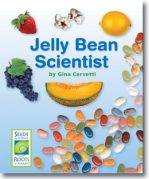
- Pencil Shavings
- Toothpaste
- Moldy Cheese
- Skunk Spray
Yuck!
The developers of the Seeds of Science/Roots of Reading program were thrilled when Ambrose agreed to be featured in a student book called Jelly Bean Scientist. In the book, readers meet Ambrose and his team of scientists who conduct tests with lab equipment and their own taste buds so the jelly bean flavors they design taste as (more…)











